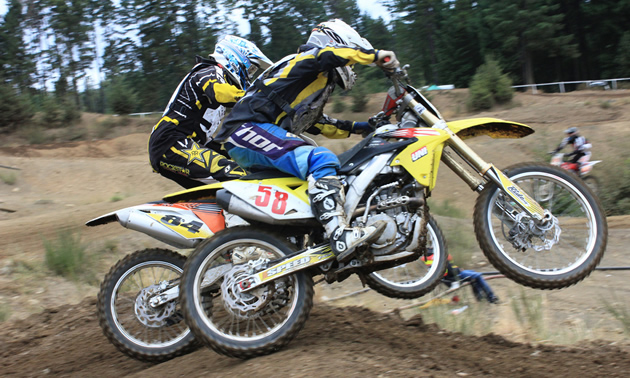With the downward spiral of these economic times, starting gates at motocross races have dwindled all across the country. The result is that many class designations have all but disappeared—making the racing less than spectacular in many of these classes.
For the Vancouver Island Motocross Association (VIMX) Fall Club Series on Vancouver Island, B.C., the powers that be decided to address this situation by combining many of the classes that have been shrinking to unsupportable numbers. What worked half a decade ago, when ridership was high, now no longer seems viable.
Merging the classes
A decent motocross race, to my mind, requires at least a dozen participants. Ideally, a class should have at least 20 riders. In the late ’70s and early ’80s it was not uncommon to have over 100 Junior racers (requiring qualifying heat races) and a full gate of 40 85-cc racers.
This season, the VIMX Championship Series was averaging about 15 Junior riders, and the 85-cc class was divided into two age groups, each of which averaged around 10 riders. Other classes like the Vet Master class, Beginner, Ladies and virtually all the MX-1 classes (450-cc) often ran with less than five riders, which is the minimum number that the Canadian Motosport Racing Corporation (CMRC) requires to run a class.
Although many of these classes, like the two 85-cc age distinctions, for example, ran on the track at the same time as other classes, they were started separately so the riders were all spread out and, actually, head-to-head racing was dramatically reduced. Many participants were dubious about the merging of classes because it meant possibly racing against faster riders.
Another hang-up is that the CMRC, our national sanctioning body, has specific classes that it runs at provincial and national championship events. Regional bodies are required to run these classes to allow qualifications for the bigger races. Since all the national, provincial and regional championships are decided by mid-summer, though, VIMX went ahead and merged many classes for their fall series. The result has been far fuller gates and better competition than we have seen on the Island in a long time.
The competition heats up
It was inevitable that VIMX’s decision to combine some of the classes for the fall series would upset some people, and I get it. I was a Vet Junior, and my kid is in the younger 85 class. Both of these classes have now been combined with supposedly “faster” classes.
There is only one reason not to like the conjoined classes; it means some riders might finish lower in the larger class than they would in the smaller class—and maybe not get a trophy or payback.
As far as the “quality of racing” is concerned, there can be no doubt that increasing gate sizes has improved competition. Aside from the sheer thrill of entering the first corner with 20-plus riders, the first race of the VIMX Fall Club Series on September 9, 2012, proved that many riders from the “slower” classes are very capable of mixing it up with riders in the “faster” classes. I saw countless instances of four or five riders, some from each class, battling it out on the track. The lower finishes really only concern me in the younger (50-cc and 85-cc) classes.
As far as the older guys are concerned, if you're in your 30s or 40s, all I can say is the Pro scouts aren't watching you anymore, your wife really doesn't care what place you finish in and I doubt the $12 payback is really going to change your life!
The pros and cons
Some parents (ironically, the kids seem less concerned) have expressed concerns that the older class will win all of the trophies and their kids will get nothing. Guess what? The evidence doesn't support these claims. The combined 50-cc class was won by Adam Polichek—who usually races in the younger class—and the first combined 85-cc class of the series ended with three of the top five riders being from the younger class! I sure hope the parents of the older kids don't start complaining that the younger kids are stealing their trophies! Joking aside, I think this is going to be an awesome series.
The combined Vet class (Vet Master/Vet Junior is now Over 30), predictably, saw all Vet Masters out front, but in this instance VIMX was kind of between a rock and a hard place. The Vet Master class has dwindled down to only four or five riders, who pretty much have a pecking order, so they end up riding around by themselves and getting bored. By combining them with the Vet Juniors, they at least get a fun start, and will often have to spend a lap or two passing riders.
The Vet Juniors do, admittedly, pay a price. By adding the 45-plus class, many of the would-be Vet Juniors get a chance to compete at the front of the pack, but those in the 35-plus class still have to face many of the Vet Masters again.
The format changes in the Vet classes were perhaps the most dramatic and potentially controversial. They were also perhaps the most targeted—in the sense that they were implemented to solve specific problems that have developed.
I think there is perhaps more potential for growth in the age classes than any others. There is an increasing demographic of aged riders getting into dirt bikes or, more often than not, getting back into dirt bikes. Motocross has become expensive enough that many riders cannot afford it until they are into their 30s. Then many of these riders take to the trails because they have the impression that motocross is for the young and mentally unstable!
VIMX wanted to find a way to attract more of these riders into motocross. I think their idea of splitting the Plus-40 class into Plus-35 and Plus-45, and starting them together, worked splendidly. We picked up a couple riders in the 35 to 40 age category and a couple more in the Plus-45 category, and by starting them together we had 16 bikes on the line, so the competition was great—there were multi-bike battles all over the track.
As mentioned, I'm less convinced about joining the Vet Master/Juniors classes.
There are essentially two kinds of veteran riders: there are those who have ridden since they were young, and those who took up the sport late (often to ride with their kids). There's usually a significant difference in the skill level between these two different types of vet riders. This was always sort of the idea of Vet Master and Vet Junior, and it was a good idea, but for whatever reason the Vet Master class has tapered off to a whimper the last few years. The smaller the numbers got, the less appealing the racing was, so the numbers got smaller still.
Finally, this spring we had an average of 4.5 Vet Masters (not legally a class!), riding around like it was practice—not much fun. So VIMX decided to put all the Over-30 riders together to make a “real” class. In theory, it seemed like a good idea, but in reality it has kind of punished, and apparently discouraged, some Vet Juniors.
If I had it to do over, I would probably vote for keeping the class distinctions, but starting them together like the Plus-35/Plus-45 class. This way, the racing on the track would still be improved, but the Vet Juniors wouldn't be put out. For the record, I did vote for joining these classes. I'm willing to admit when I've made a mistake.
We had 12 bikes on the starting line, which is not bad, but it's not what I would have hoped for. If I add the average number of Vet Juniors and Vet Masters in the spring, we should have had about 15 guys in the Over-30 class.
Anyways, as mentioned, the racing was much improved regardless. For the most part, it seems like the majority of the older guys are primarily out to have fun, and find guys to dice with on the track. They seemed to be happy that the changes are increasing the odds of both occurring.
Where the big-wheel riders fit
Dropping the MX-1 class in Junior and Intermediate was a no-brainer. At most, we get one or two big bikes signing up most weekends.
Running only a GP class in these skill level classes, however, created the problem of finding a second class for these riders (race schedules generally try to provide two classes for most riders). So VIMX created an Under-30 class, which is similar to the pre-existing Youth class (under 25), but it allowed riders right up to the Over-30 distinction. Thus, all big-wheel riders would fall into either the Under- or Over-30 category, and have a second class option.
We knew the Under-30 class would be dominated by Intermediates, but I think this class serves a good purpose for the fall. Many of the Juniors who have the option to move up to Intermediate are being given a chance to race against them and get a feel for the water before they dive in. As I expected, many of these Juniors do pretty well against mid-pack Intermediates.
It was several laps into both of the Under 30 motos before the top positions were all filled by Intermediates, and behind them there was racing between Intermediates and Juniors going on all over the track for the entire duration of the race.
“The times, they are a changin’ ”
All in all, given that the goal of the Fall Club Series is to have fun and gain experience, I think joining these classes was a huge success. Hats off to VIMX for throwing the dice on these changes, and to the vast majority of racers who seem to be embracing them. Now, the next step is getting CMRC to see the logic in shrinking classes across the country.
As Bob Dylan sang, “The times, they are a changin.’ ” I think it is imperative that motocross sanctioning bodies change with the times and adjust classes to reflect the ridership that is attending.








Comments